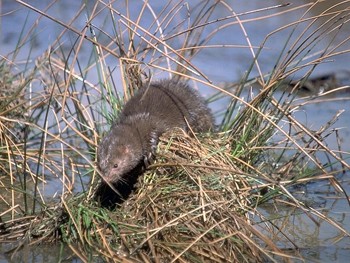Hebridean mink project

It?s not often that a government agency is seen as trailblazing when it comes to wildlife management. But as far as Scottish Natural Heritage?s (SNH) islands-based Hebridean mink project is concerned, it seems to have donned this mantle. Its decision to use remote trap-monitoring devices may pave the way for others to follow suit, provided users can afford the cost and ensure that they stay on the right side of animal welfare regulations.
SNH has run a major program for the past six years to eradicate the American mink from the Western Isles. Now in its final phase, the project has introduced remote trap-monitoring as part of its adaptive management strategy. Project managers are enthusiastic about their achievements. So far some 1,600 mink and 100 wild ferrets have been taken from Lewis and Harris using a network of 7,500 cage traps and 500 monitoring devices.
Over this time, a picture of how mink operate in both the freshwater and marine environments has emerged, and there is now a growing belief that fewer than 50 adult animals remain. If these can be trapped, along with this season?s crop of kits, it could spell extinction for the American invader. However, as with all wildlife management, it is generally accepted that getting the last few mink will be a challenge. This means catching opportunities need to be maximised.
While wildlife charities have embraced the project?s aims, not everyone welcomes the minks? demise. As numbers have fallen, many islanders believe that the rat population has exploded. A recent letter to the local press complained about the resurgence of rabbit numbers. There have even been veiled threats to augment the remaining mink with fresh blood ? confirmation indeed that not everyone supports the aim of eradication, even of an introduced predator.
Technical solution
Technology surrounds us in all aspects of our daily life ? fieldsports and wildlife management are no exceptions. Look at our use of stealth cams and the myriad other gizmos we take for granted, including trap-monitoring devices. Their use potentially offers professional and amateur keepers the prospect of increased success, if they can be confident that the technology is reliable and does not contravene the law.
In late 2012, a Danish developer approached SNH offering to work with the agency in trialling his product ? the appropriately named Mink Police ? in Scotland. The device has been available for some time in Denmark, where its use is sanctioned. While remote monitoring units have been around for a while, there have been questions about whether their operation complies with animal welfare legislation, particularly in terms of their ability to report reliably. The Danish unit, which is small, waterproof and mechanically simple to use, is backed up with a web-based control and data system. SNH felt that these features, plus the chance of working directly with the developer, would allow it to customise the system to meet its needs.
The Scottish Executive was consulted throughout the development and is confident that this particular unit, the protocols for its operation, and the stringent field tests carried out from November 2012 comply with Animal Welfare legislation. SNH began operational testing using five units. Initial testing was backed up by daily visits to confirm operation and to cross-check communication. These tests established a long sequence of successful operational trap days. As the testing period enters its sixth month, some 45 devices are now deployed and SNH intends to move to fully remote trap-monitoring.
Initially targeted against ferrets and rats, the first mink was taken in April. SNH is confident that the use of monitoring units can be extended to other species and intends to make a best practice guide available to the public.
Progressive approach
Ian Clark, from the Scottish Association of Country Sports, broadly welcomes the progressive approach shown by SNH in supporting the introduction of these devices. He agrees they are a useful indicator of the traps? status, but he does not feel they are a viable alternative to carrying out a daily visual inspection of each open trap. His advice would be to use them in addition to daily checking but not to rely on them.
For most small-scale operators, the biggest initial disincentive is likely to be cost. Currently the devices are listed at ?240. When you factor in the additional cost of a SIM card, the set-up cost per unit may well be out of the comfort range of all but large corporate organisations, or shoots with deep pockets. However, their use can be extended to a variety of target species and is not restricted to live capture traps. Undoubtedly, they have the potential to be a flexible addition to the resources available to wildlife managers. Perhaps, as with all technology, cost will reduce as demand increases and they become more available over time.








